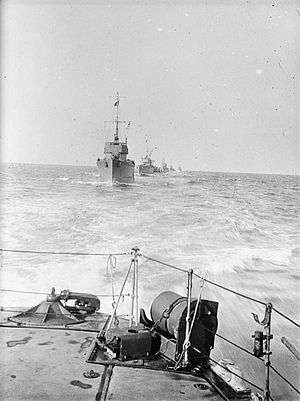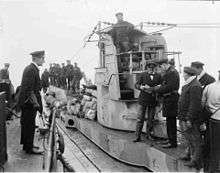Harwich Force
The Harwich Force originally called Harwich Striking Force [1] was a squadron of the Royal Navy, formed during the First World War and based in Harwich. It played a significant role in the war.
| Harwich Force | |
|---|---|
 Destroyers of the Harwich Force in line ahead | |
| Active | 1914–1918 |
| Country | |
| Allegiance | British Empire |
| Branch | Royal Navy |
| Type | Naval Fleet |
| Engagements | Battle of Heligoland Bight Battle off Texel Battle of Dogger Bank Battle off Noordhinder Bank |
| Commanders | |
| Notable commanders | Reginald Tyrwhitt |
History
After the outbreak of the First World War, a priority for the Royal Navy was to secure the approaches to the English Channel, to prevent elements of the German High Seas Fleet from breaking out into the Atlantic, or from interfering with British maritime trade and convoys to the continent.[2] Most of the major fleet units of the Grand Fleet had dispersed to the navy's anchorage at Scapa Flow or to other North Eastern ports to monitor the northern route from the North Sea into the Atlantic. Consequently, a number of patrol flotillas were organised along the south and east coasts of England, with commands established at several of the major ports in the region.[2] The Dover Patrol was based at Dover, consisting mostly of destroyers, while a number of pre-dreadnoughts and cruisers were based at Portland Harbour. A large number of destroyers, flotilla leaders and light cruisers were centred at Harwich, under the command of Commodore Reginald Tyrwhitt.[2]
Composition
The Harwich Force consisted of between four and eight light cruisers, several flotilla leaders and usually between 30 and 40 destroyers, with numbers fluctuating throughout the war, and organised into flotillas. Also stationed at Harwich was a submarine force under Commodore Roger Keyes.[2]
In early 1917, the Harwich Force consisted of eight light cruisers, two flotilla leaders and 45 destroyers. By the end of the year, there were nine light cruisers, four flotilla leaders and 24 destroyers.[3] The combination of light, fast ships was intended to provide effective scouting and reconnaissance, whilst still being able to engage German light forces, and to frustrate attempts at minelaying in the Channel.[3]
Rear-Admirals
Post holders included:
| Rank | Flag | Name | Term | Notes | |
|---|---|---|---|---|---|
| Rear-Admiral Commanding, Harwich Force | |||||
| 1 | Rear-Admiral | Reginald Tyrwhitt | 7 April 1914 – 1 May 1919[4] | receiving shore support from FOIC, Harwich | |
| 2 | Rear-Admiral | George Holmes Borrett | 1 March 1919[5] | ditto | |
| Rear-Admiral-in-Charge, Harwich | |||||
| 1 | Rear-Admiral | George Cuthbert Cayley | 2 July 1917 – 31 March 1918[6] | in charge of the base at Harwich Dockyard | |
| 2 | Rear-Admiral | Cecil Spencer Hickley | 1 April 1918 – 1 March 1919[7] | ditto | |
Service
It was intended that the Harwich Force would operate when possible in conjunction with the Dover Patrol, and the Admiralty intended that the Harwich force would also be able to support the Grand Fleet if it moved into the area. Tyrwhitt was also expected to carry out reconnaissance of German naval activities in the southern parts of the North Sea, and to escort ships sailing between the Thames and the Netherlands.[3] Tyrwhitt's objectives were often complicated by the need to provide reinforcements for the Dover Patrol. The force fired the first shots of the war when a flotilla led by HMS Amphion sank the minelayer Königin Luise on 5 August 1914.[8] During the war, the Force captured or sank 24 enemy merchants, and it escorted 520 eastbound and 511 westbound ships between Dutch and British ports.[3] Their ships also took part in the Cuxhaven Raid on Christmas Day, 1914.

The force was also active in a number of clashes with the Kaiserliche Marine (German Navy). Their ships were present at the Battles of Heligoland Bight, Texel, and Dogger Bank, and were mobilised after the German raids on Scarborough, Hartlepool and Whitby in 1914, and on Yarmouth and Lowestoft in 1916. They were called out during the lead up to the Battle of Jutland, but did not take part in the battle.[8] After the end of the war, Harwich was designated the port at which the remaining German U-boats would be surrendered, and Tyrwhitt's Harwich Force oversaw the operation.[9]
Battle of Jutland
At the end of May 1916, at the time of the Battle of Jutland, the Harwich force consisted of:
- 5th Light Cruiser Squadron:
- Carysfort (Commodore Tyrwhitt)
- Cleopatra (Captain F. P. Loder-Symonds)
- Conquest (Captain Roger Backhouse)
- Canterbury (Captain Percy Royds, detached to Grand Fleet)
- Penelope (Captain Hubert Lynes; undergoing repairs)
- Vindex, a seaplane carrier (detached to Rosyth, Scotland)
- 9th Destroyer Flotilla
- light cruiser Undaunted (Capt. Francis G. St.John)
- destroyer leader Nimrod
- 17 (L-class) destroyers (Laforey, Lance, Lark, Lassoo, Laverock, Lawford, Leonidas, Lookout, Loyal, Lysander; detached to the Battlecruiser Fleet: Landrail, Laurel, Liberty, Lydiard; in repairs or refitting: Laertes, Lennox, Lucifer)
- 10th Destroyer Flotilla
- light cruiser Aurora (Capt. Wilmot S. Nicholson)
- destroyer leader Lightfoot
- 15 M-class and 3 Talisman-class destroyers. Manly, Mentor, Miranda, Murray, Milne, Myngs; attached to the 3rd Battle Squadron at The Nore: Mastiff, Matchless; detached to the Battlecruiser fleet: Moorsom, Morris, Termagant, Turbulent; in repairs or refit: Melpomene, Medea, Meteor, Trident, Mansfield, Minos.
The Harwich Force sortied to join the Grand Fleet on the initiative of Commodore Tyrwhitt early on 1 June 1916 in the hope that it might help should the action be re-joined later in the day, but it was recalled by the Admiralty a few hours later and told to await orders. The following ships had sortied:[10]
- light cruisers: Carysfort, Cleopatra, Conquest, Aurora, Undaunted
- flotilla leaders Nimrod, Lightfoot
- destroyers:
- 1st Division: Laforey, Lookout, Lawford, Laverock
- 2nd Division: Lance, Lassoo, Lysander, Lark
- 3rd Division: Loyal, Leonidas, Mentor, Miranda
- 4th Division: Manly, Murray, Milne, Myngs
Notes
- Churchill, Winston (2005). The World Crisis, 1911-1918. New York, NY, USA: Simon and Schuster. p. 169. ISBN 9780743283434.
- King-Hall. The War on Sea. pp. 11–12.
- Jellicoe. The crisis of the naval war. pp. 127–9.
- Archives, The National. "Commodore 'T', Reginald Y Tyrwhitt, Rear-Admiral commanding Harwich Force, diary of events, 30 December 1917 to 19 April 1919". discovery.nationalarchives.gov.uk. The National Archives UK. Retrieved 5 February 2017.
- Lovell; Harley, Tony; Simon (10 March 2018). "George Holmes Borrett". The Dreadnought Project. Retrieved 4 June 2018.
- Lovell; Harley, Tony; Simon (28 August 2017). "George Cuthbert Cayley". The Dreadnought Project. Retrieved 15 February 2018.
- Lovell; Harley, Tony; Simon (31 August 2017). "Cecil Spencer Hickley". The Dreadnought Project. Retrieved 4 June 2018.
- Tucker. World War I: Encyclopedia. p. 1192.
- Massie. Castles of Steel. p. 780.
- The Admiralty. Jutland Despatches. pp. 341–342.
References
- Jellicoe, Viscount Jellicoe Of Scapa (1920). The crisis of the naval war.
- Tucker, Spencer (2005). World War I: Encyclopedia. ABC-CLIO. ISBN 1-85109-420-2.
- King-Hall, Stephen (1929). The War on Sea: 1914–1918. London: Ernest Benn Limited.
- Massie, R. K. (2004). Castles of Steel: Britain, Germany and the Winning of the Great War at Sea. New York: Ballantine Books. ISBN 978-0-345-40878-5.
- The Admiralty (1920). Battle of Jutland, 30th May to 1st June 1916: Official Despatches with Appendices. London: H.M. Stationery Office.
External links
| Wikimedia Commons has media related to Harwich Force. |